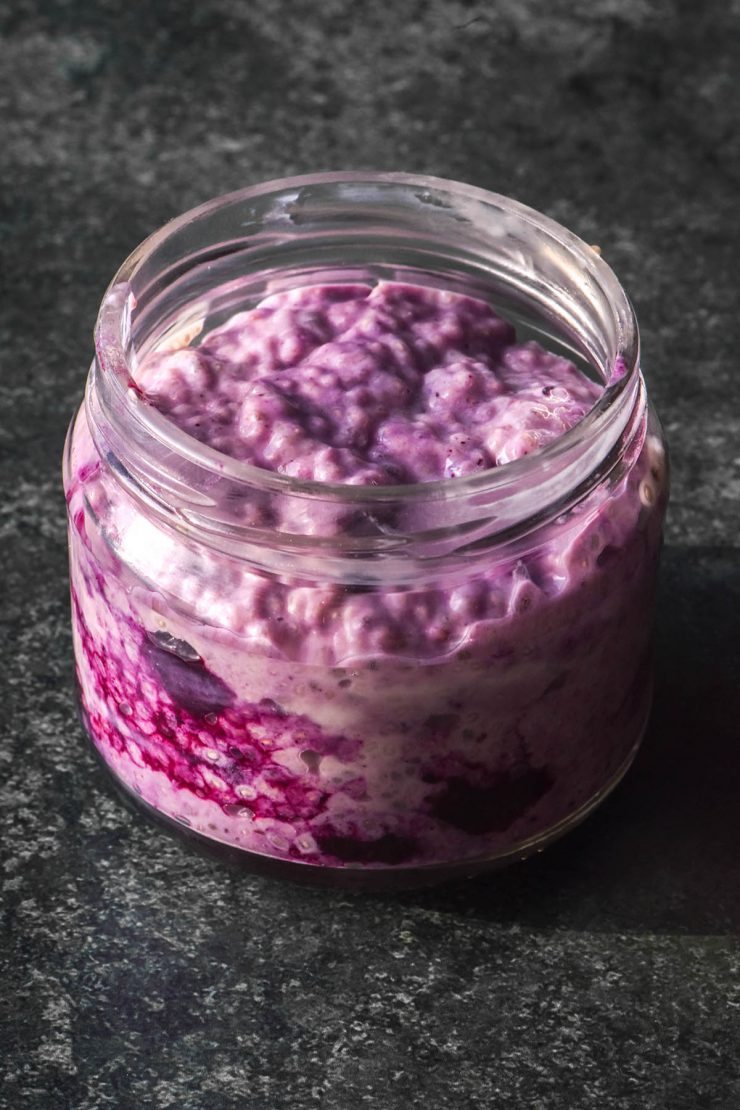
Every now and again I get a real craving for chia pudding. When made right, it tastes like dessert to me. I have, however, made a lot of runny chia puddings (or milk with chia) in my time. With both of these facts in mind, I decided to knuckle down and develop a non-runny recipe for low FODMAP chia pudding.
Low FODMAP chia pudding
This chia pudding is an easy low FODMAP make ahead breakfast. It is a single serve recipe. Sometimes I find that I can’t eat chia pudding every single day (in terms of FODMAPs and all that fibre) hence the single serve recipe. However, you can also scale up and make the puddings directly in individual jars. Add the ingredients in, give them a good shake and pop them in the fridge for the following morning.
Although this pudding is delicious as is, you can also add some low FODMAP fruit, a spoonful of nut butter, some low FODMAP protein powder or all of the above. We’ll go into all of the options below.
This chia pudding is gluten free, vegan adaptable and nut free without any additions. It makes a perfect high fibre snack or breakfast that I absolutely love.
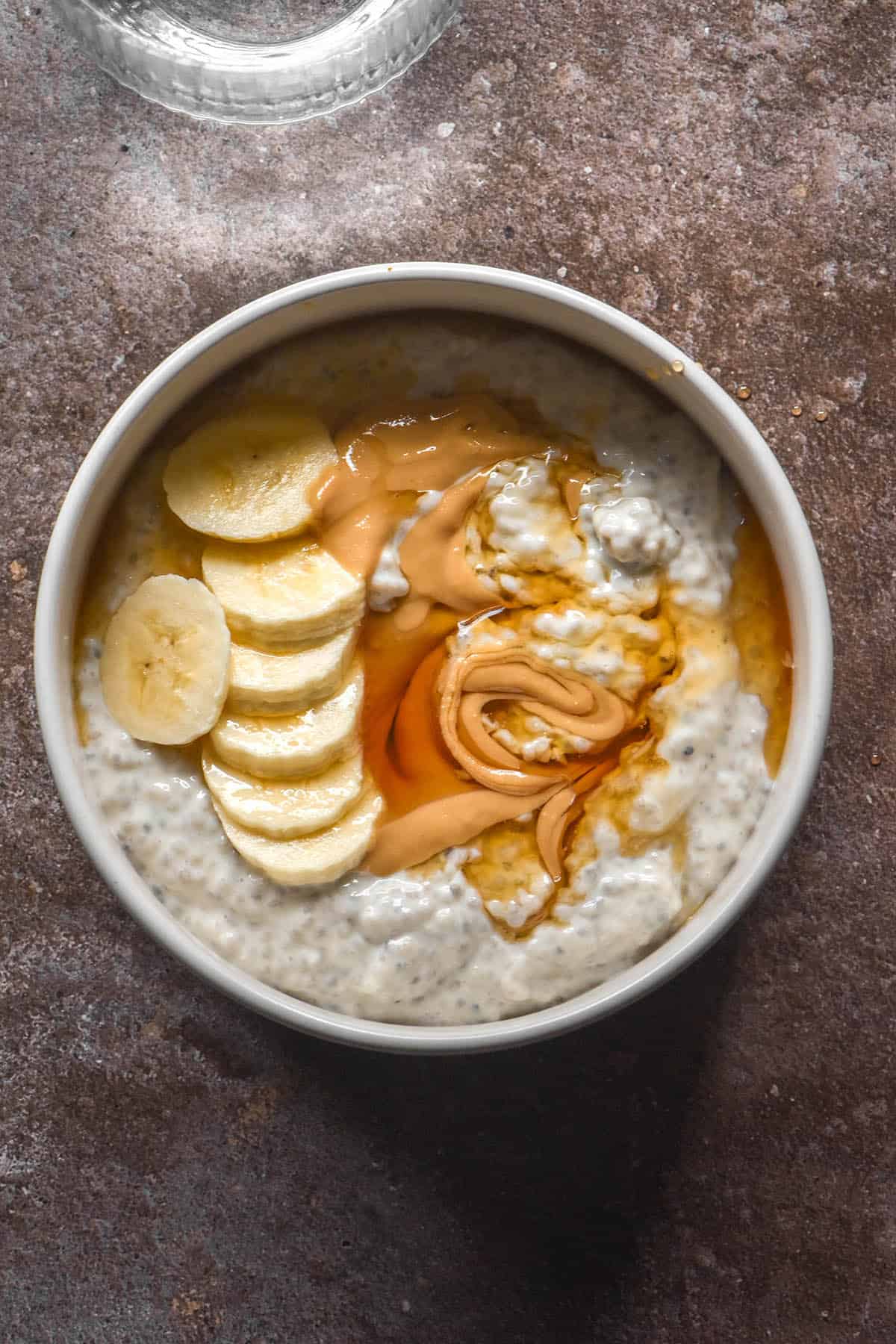
Are chia seeds low FODMAP?
Both black and white chia seeds have a low FODMAP threshold of 28g per serve. This is approximately 2 Australian tablespoons, but for accuracy it is best to weigh them. Monash have deleted a lot of their upper FODMAP thresholds at the time of writing and they removed the upper threshold for chia seeds. The entry used to specify that 48g serves or approximately 4 tablespoons contains high amounts of fructans.
Can I freeze this low FODMAP chia pudding?
Yes, you can. I have tested freezing a milk only chia pudding and a milk and yoghurt chia pudding. I found that both worked nicely, but the milk version had more separation in the centre.
With the yoghurt version, you don’t have to wait for the chia seeds to gel before freezing the mixture as it won’t set straight away. If you don’t want to use yoghurt, I found a milk only version separates a little when frozen (a layer of chia on the bottom, milk in the centre, another layer of chia on to). I’d be more inclined to suggest allowing a milk only version to set before freezing.
But back to the version in the recipe card (aka the yoghurt version): simply mix them up and then pop them in the freezer. Allow the pudding to come to room temperature before consuming – I like to transfer mine from the freezer to the fridge the night before I intend to eat it.
One thing to keep in mind, however, is the container you freeze your chia pudding in. I like to make my chia pudding in leftover jars, but I have had a few freezer-glass mishaps in the past. So, I did a bit of research and found this incredibly helpful article. I’d recommend reading it if you’d like to freeze your chia pudding in glass jars.

High protein low FODMAP chia seed pudding
There are some easy ways to amp up the protein content of your chia pudding. Firstly, it’s worth noting that milk can have a respectable amount of protein in it, depending on the variety you use.
For example, lactose free full fat milk has 4g of protein per 125ml (1/2 cup). Soy milk made from soy protein (as opposed to whole soy beans, see below) has about the same amount of protein (with variance from brand to brand). There are also some brands that are ‘protein boosted’ on the shelves these days.
There are a number of high protein yoghurts available these days. In Australia, Chobani Fit (specifically the Fit line) is lactose free (with added lactase) and contains 15g of protein. With lactose free milk and high protein yoghurt, we’re already looking at nearly 20g protein. The tubs contain 160g of yoghurt which is slightly more than the recipe specifies, but feel free to add the whole tub. I have seen coconut yoghurt protein yoghurts on the shelves, too.
To amp it up even more, you can use a low FODMAP protein powder. I have an article on low FODMAP protein powders which you can find here.
Two more options to add a hit of low FODMAP protein are natural peanut butter and hemp seeds. Peanut butter is low FODMAP in 50g serves, which Monash says is approximately 2 tablespoons. 20g of Mayvers peanut butter (the brand I have at the moment) contains 5g protein. Other brands might have a slightly different protein content.
Finally, hemp seeds. Hemp seeds are low FODMAP in 20g serves or approximately 2 tablespoons. In servings of 50g, they are moderate for GOS. 1 tablespoon of hemp seeds can contain around 4g protein (but read the label of the brand you buy).

Can I make a low FODMAP vegan chia pudding?
Yes, you can. To make a vegan version of this recipe, use a good quality coconut yoghurt in place of the yoghurt. Ensure it doesn’t contain any high FODMAP ingredients such as inulin, chicory or high FODMAP fruits. Look for a natural or plain flavour so you can sweeten your chia pudding according to taste.
Monash lists coconut yoghurt as being low FODMAP in 125g serves, which the precise amount this recipe uses. Soy yoghurt has a much smaller FODMAP threshold of 38g – 49g contains moderate amounts of fructans. I recommend using coconut yoghurt for ease. Bonus: I have seen some high protein coconut yoghurt tubs on the market.
Of course, you’ll also need to use plant based milk in place of the lactose free milk. Have a read of the section below for low FODMAP plant based milks.
Finally, if you intend to add some protein powder you will of course need to use a plant based version. Be sure to read the labels as they often contain a whole host of ingredients which can be high FODMAP.
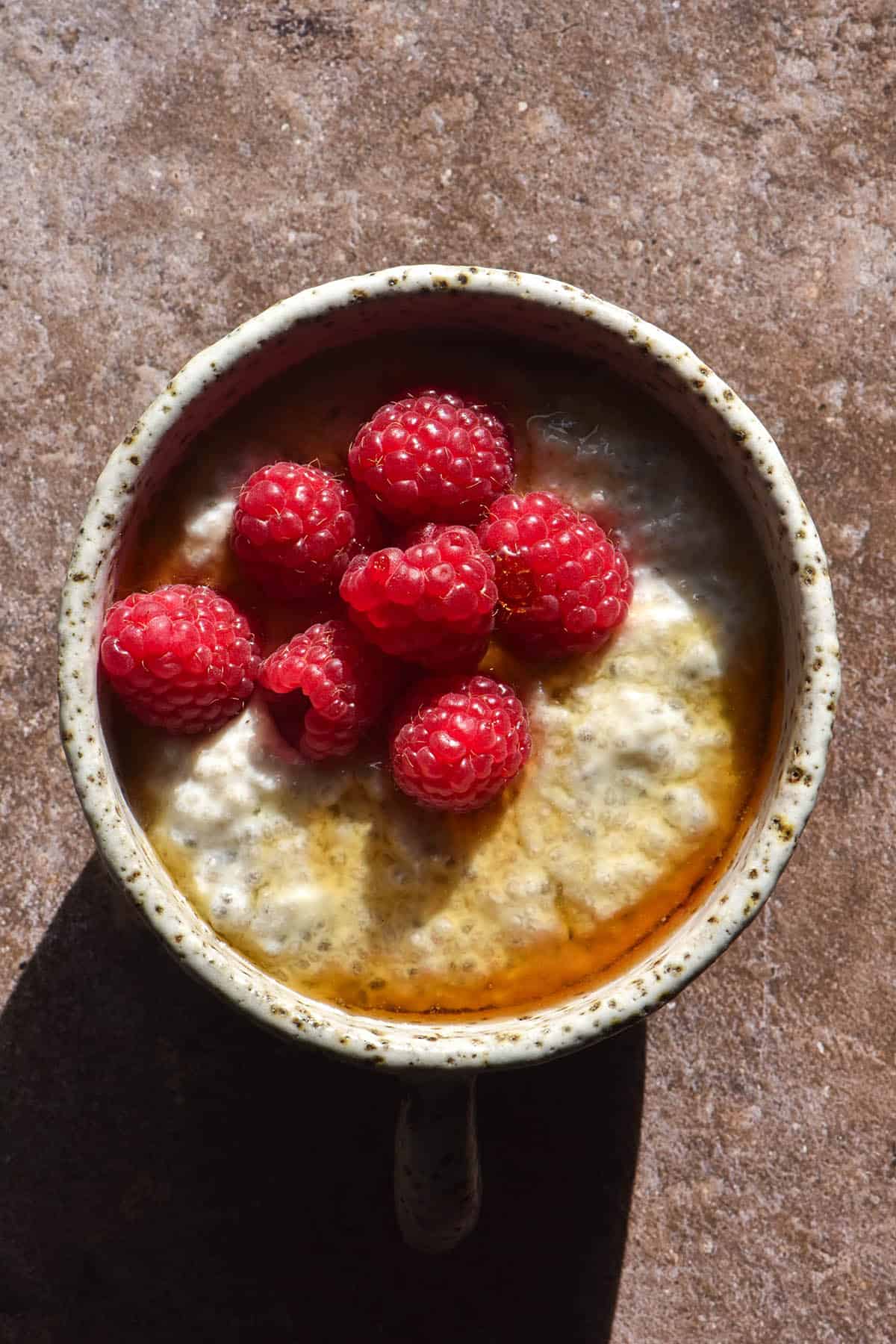
Low FODMAP milk and yoghurt for your chia pudding
Choosing a low FODMAP milk can be a bit confusing, so I thought I would collate them all into one spot. These thresholds are current as of June 2024 and will be periodically updated to remain current.
- Almond milk is low FODMAP in 240g (1 cup) serves
- Hemp seed milk is low FODMAP in 120g (1/2 cup) serves. It doesn’t contain moderate amount of fructans until it exceeds 240g (1 cup) serves, so I daresay using 125ml should be fine.
- Rice milk is low FODMAP in 200g (3/4 cup) serves. Monash doesn’t specify an upper limit.
- Macadamia milk is low FODMAP in 240g serves (1 cup). Monash doesn’t specify an upper limit.
- Oat milk is low FODMAP in 104g serves. In 121g serves, it contains moderate GOS and fructans. You could use 104g (6 tablespoons) oat milk and the remainder water, but I don’t think you could also use oat yoghurt (Monash doesn’t have an entry for that at the moment). Keep in mind that oats are not considered gluten free in Australia, so avoid this option if you are coeliac.
- Regular (ie lactose containing) cow skim milk is low FODMAP in 20g serves. It contains moderate amounts of lactose in serves exceeding 80g.
- Lactose free cow milk is low FODMAP in serves of up to 500g.
- Unsweetened quinoa milk is low FODMAP in 240g serves. Monash doesn’t specify an upper limit.
- Milk made from soy protein is low FODMAP in 247g serves (1 cup). Monash doesn’t specify an upper limit.
- Milk made from soy beans has no safe low FODMAP threshold. Choose soy protein based milk if you’d like to use soy milk.
- Light coconut milk remains low FODMAP in serves of up to 500g.
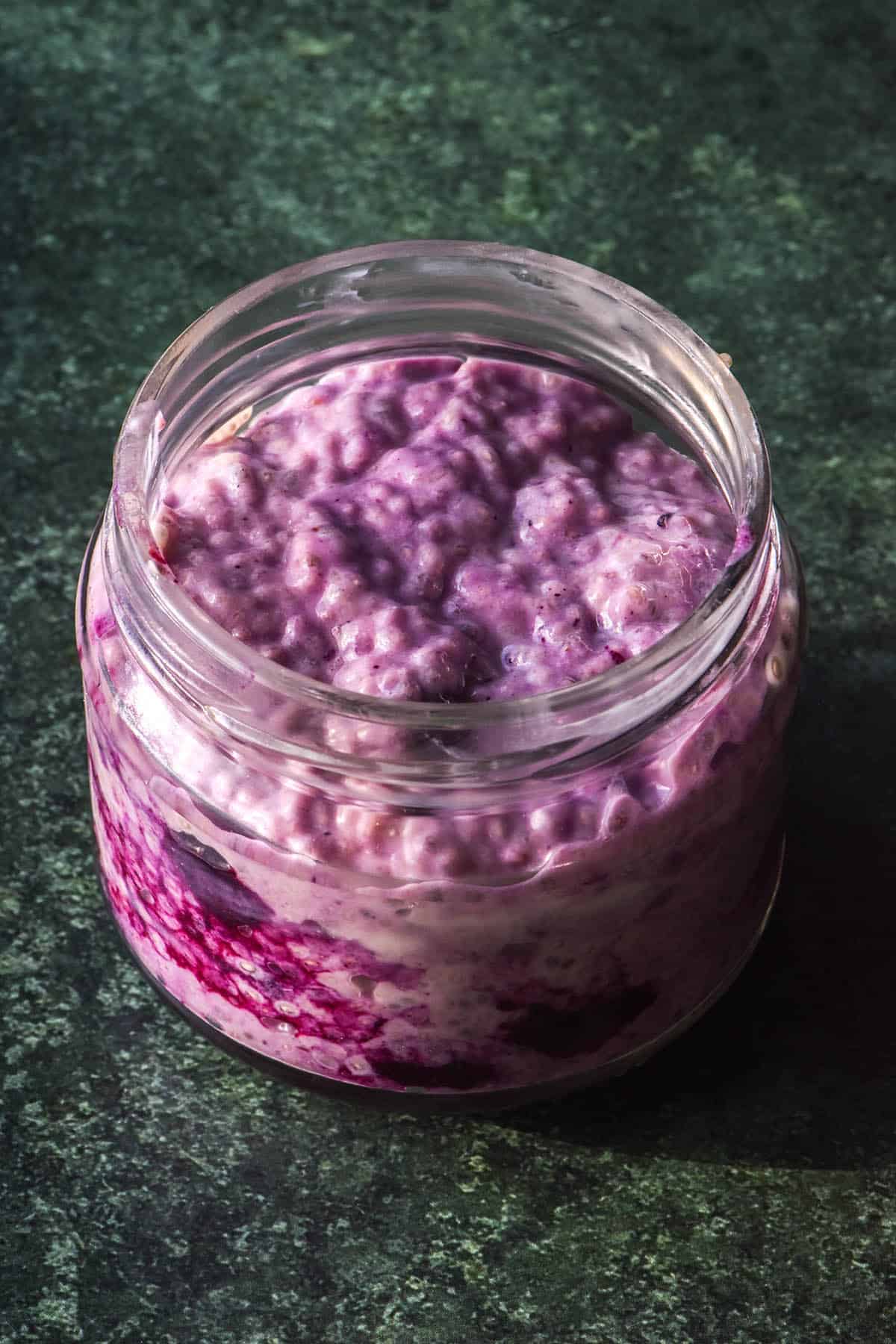
Do I have to add yoghurt?
I highly recommend adding yoghurt to your low FODMAP chia pudding. For starters, it makes the pudding much more substantial and filling. If you choose a high protein yoghurt, too are already off to a good start for the day.
Secondly, for whatever reason, chia seed pudding with yoghurt thickens a lot more quickly than a milk only version. A milk and yoghurt combination for chia pudding suspends the chia seeds in the batter and they begin to swell almost immediately. I don’t find this to be the case with a milk only version. I generally find that the chia seeds, even when stirred through thoroughly, tend to form a ‘skin’ of chia seeds atop milk, rather than incorporating into the mixture.
In my milk chia pudding experiments, adding extra milk in place of the yoghurt resulted in a very thin chia pudding. So, at the very least, don’t add extra milk to compensate for the yoghurt if you insist on making this without yoghurt.
The benefit of yoghurt in chia pudding
Below are two chia puddings that I mixed up and froze immediately – no time in the fridge or on the bench. The top pudding uses only milk, whereas the bottom pudding uses the recipe in the recipe card with both milk and yoghurt. Notice that the chia in the top milk only pudding has formed two distinct bands of chia. The milk sits solid in the centre of the layers of chia.
The bottom pudding uses both milk and yoghurt. As you mix this version of the recipe, you’ll notice that the chia seeds incorporate much more evenly into the liquid. They don’t form a layer of chia at the top and the pudding doesn’t require multiple mixes before you let it set. This is reflected in the frozen pudding – evenly distributed from the get go. This same reaction occurs using vegan yoghurt and milk, too.
I don’t know why this happens – initially I wondered if the acid in yoghurt might activate the chia. I made a batch of milk based chia pudding with added lemon juice to see if acid caused the chia to swell more quickly and suspend evenly in the liquid, but it didn’t work like yoghurt.
It could just be that the thickness gives the chia something to cling to. If anyone with a clue or a food science degree has the answers, I’d love to know!
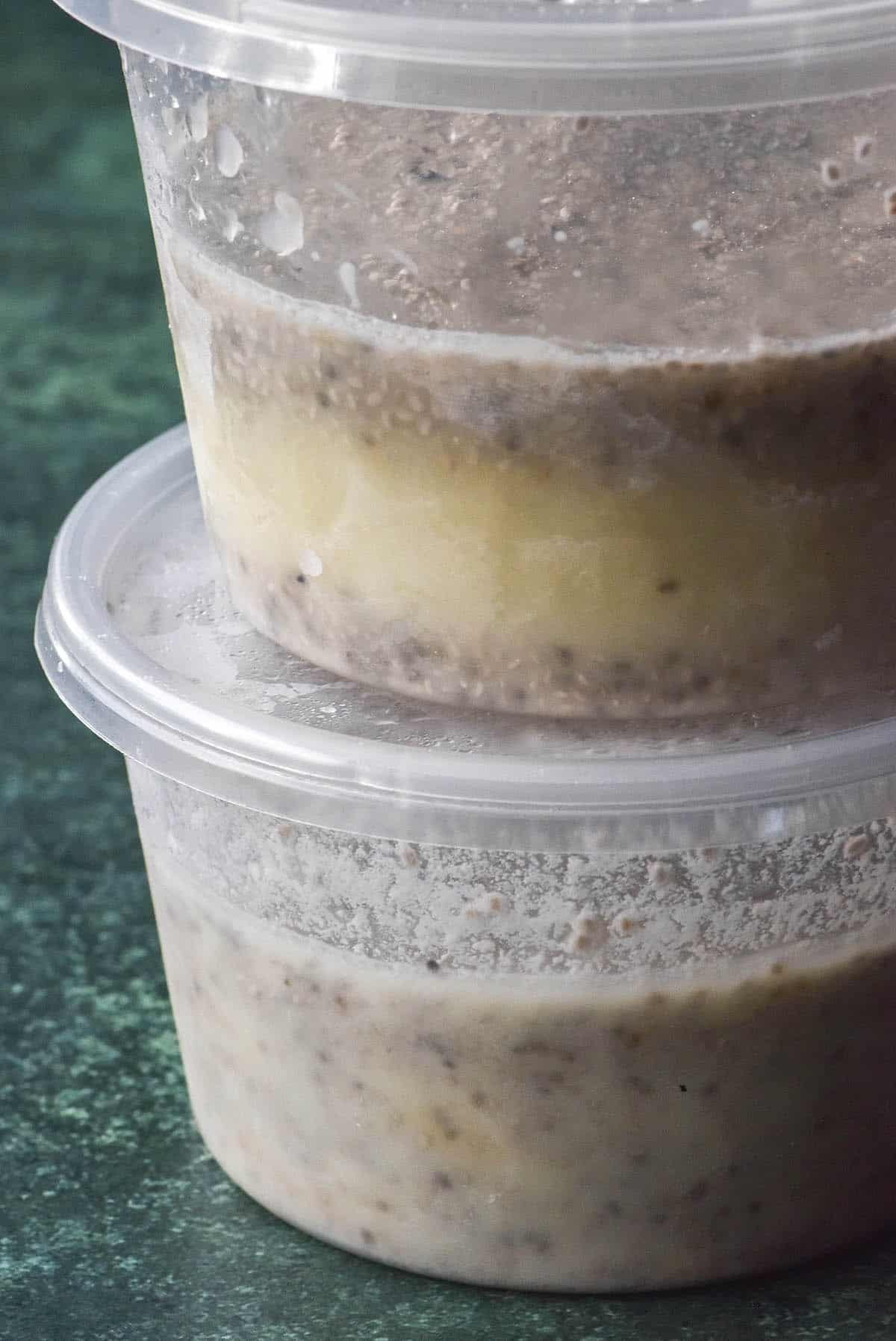
Low FODMAP toppings for your chia pudding
I love to add a bit of texture and flavour to a chia pudding. Here are some of my suggestions:
- I have a list of low FODMAP nuts and seeds (and their thresholds) here.
- Blueberries remain low FODMAP in serves of up to 500g. In some of the photos, I used about 1/4 – 1/3 cup of frozen blueberries that were defrosted with a teaspoon or so of water.
- Raspberries are low FODMAP in 58g serves (around 1/3 Australian cup).
- Slightly underripe banana is low FODMAP in 100g serves (roughly 1 medium banana). It becomes moderate in fructan in 110g serves.
- Firm sugar bananas are low FODMAP in up to 500g serves per person. Ripe sugar bananas are low FODMAP in 112g per person.
- Peanut butter is low FODMAP in 50g serves (in Australia, it is lower in the US).

More low FODMAP breakfast and snack recipes
- Low FODMAP granola bars (oat free, gluten free, vegan)
- Low FODMAP granola (oat free, gluten free, vegan)
- Gluten free porridge (using rice flakes)
- Gluten free vegan bagels without xanthan gum
- Gluten free buckwheat bread
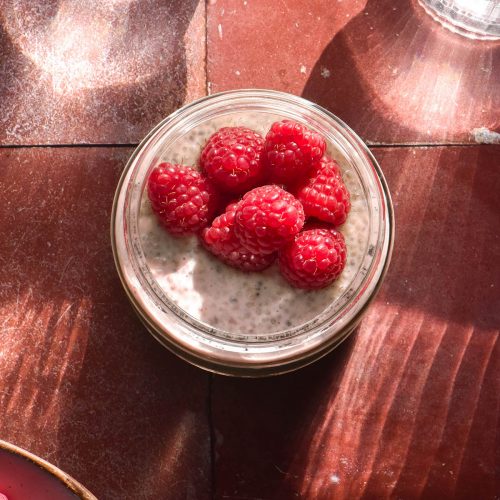
Low FODMAP chia pudding
Ingredients
- 100-125g+ lactose free yoghurt of choice (see notes for suggestions and notes on quantity; see body of the post for FODMAP thresholds)
- 125ml (1/2 cup)* low FODMAP milk of choice (see body of post for low FODMAP milk options)
- 28g (2 tablespoons)* white or black chia seeds
- 20ml + (1 tablespoon +)* maple syrup, to your tastes (see notes for FODMAP thresholds)
Instructions
- Whisk the yoghurt and milk together in the vessel of your choosing.
- Whisk in the chia seeds until they are all separated and distributed throughout the mixture.
- Add the maple syrup according to your tastes.
- Place the chia pudding in the fridge for at least 1 hour (approximately how long it takes to set) or overnight.
- If your pudding is too firm when you come to serve it, add a small splash of water to loosen to your ideal consistency. Serve with low FODMAP toppings of your choice (see body of post for suggestions).
- Chia pudding can also be stored in freezer safe containers and frozen. Simply bring it up to room temperature before consuming.
Notes
- Lactose free Greek yoghurt and coconut yoghurt are what I have tested here. In Australia, Jalna and Chobani (the Fit range) make lactose free Greek yoghurt. Both should be available at the major supermarkets.
- Coconut yoghurt is a great vegan option which is low FODMAP in 125g serves, according to Monash. I used Coyo Greek style yoghurt (along with soy milk made from soy protein, which was a delicious combination) for a vegan option.
- You can use protein yoghurt or sweetened yoghurts, but be mindful of the FODMAP content (particularly in yoghurts with fruit pieces). I’d recommend Chobani Fit protein yoghurts which are lactose free.
- If you have a little more yoghurt than the recipe specifies, feel free to add it. It won’t ruin your pudding.
- Add sweetener to taste, particularly if you are using a sweetened yoghurt.
- Maple syrup is low FODMAP in 50g serves (2 tablespoons) per meal. Monash doesn’t specify an upper limit. You could also experiment with rice malt syrup but it is a much more subtle sweetener.
- I haven’t tested and don’t have any experience with artificial sweeteners.
- Add sweetener to taste if you have used a sweetened yoghurt.
- You can also add all the ingredients to a jar and shake vigorously to combine. This is an easier method when making chia pudding for meal prep.
- In some of the photos, I used about 1/4 – 1/3 cup of frozen blueberries that were defrosted with a teaspoon or so of water.

No Comments